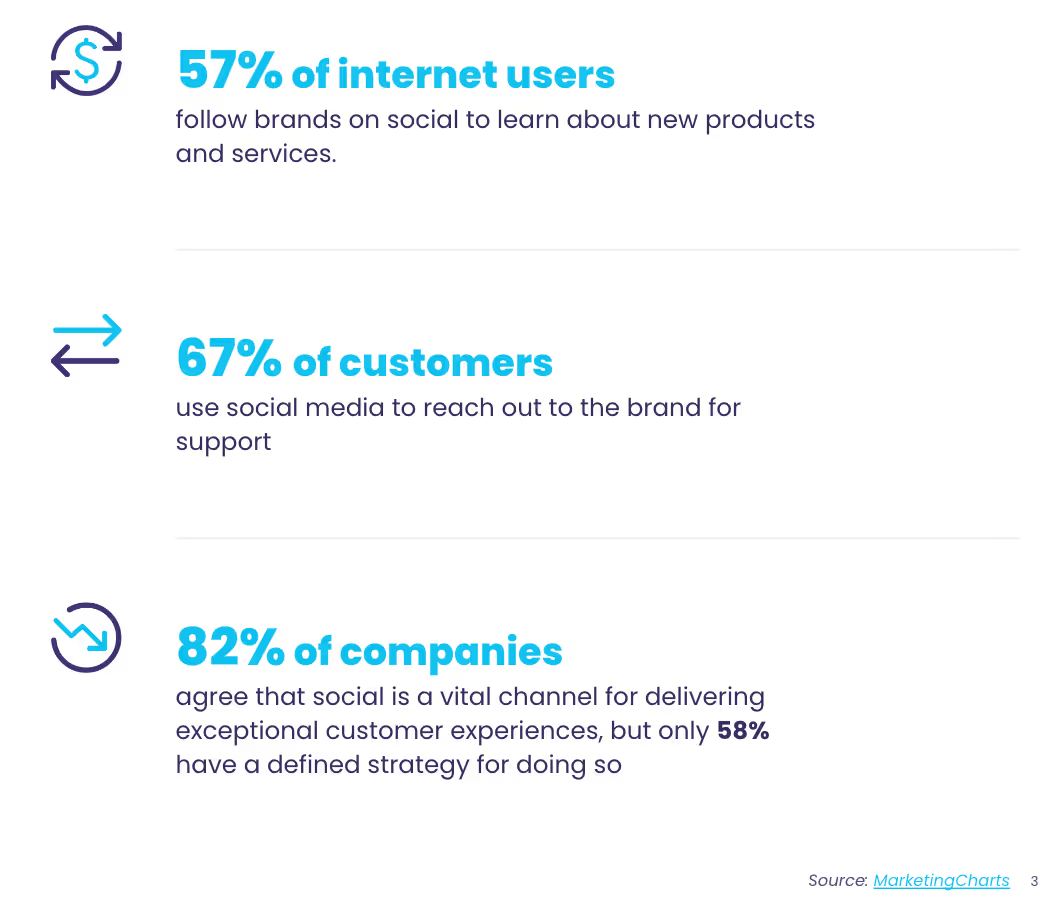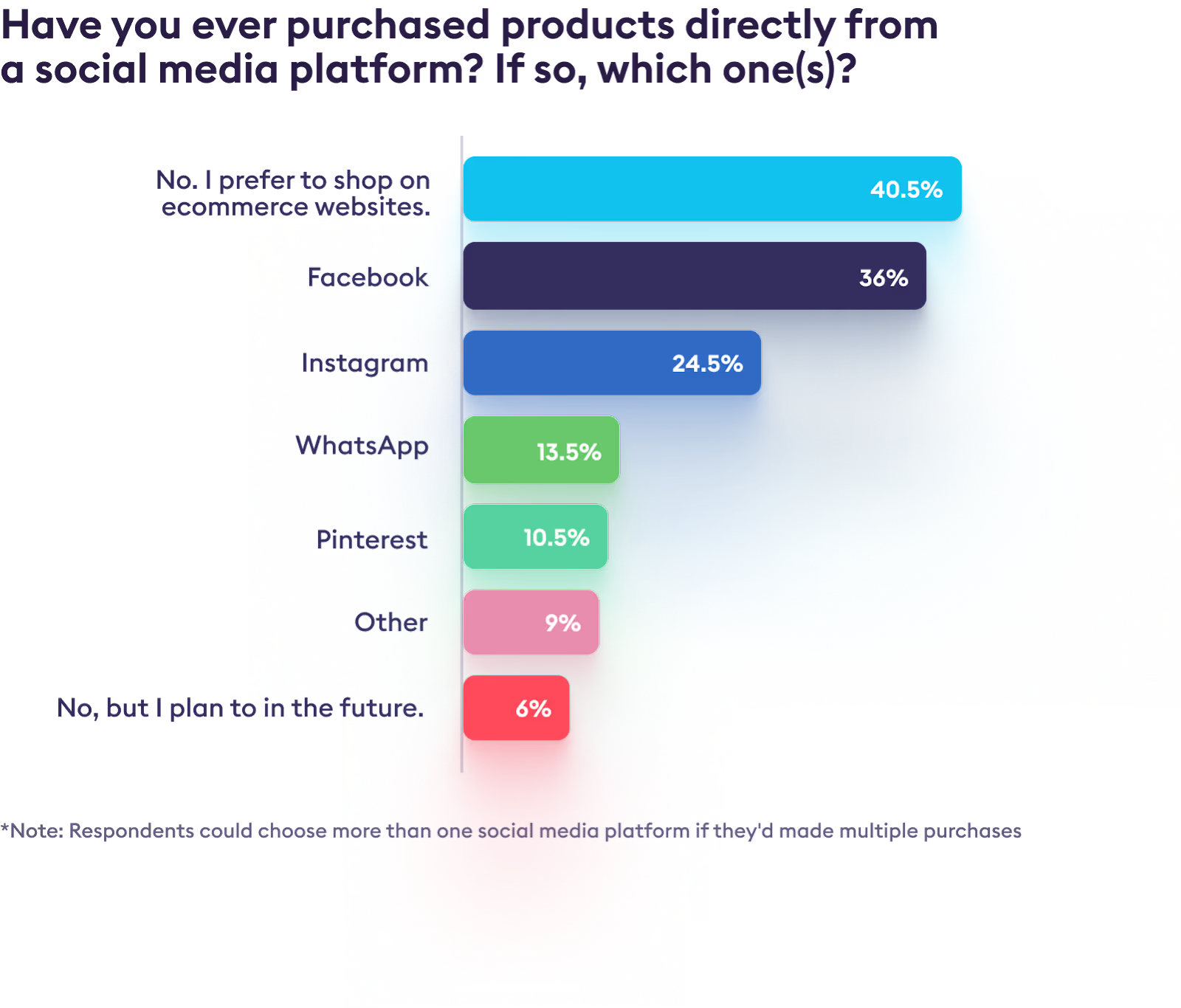It’s completely natural. Social media is already an integral part of the customer experience. In most cases, it’s the most frictionless method to engage with brands.

57% of internet users follow brands on social to learn about new products and services, 67% of customers use social media to reach out to the brand for support, and 82% of companies agree that social is a vital channel for delivering exceptional customer experiences. With every passing year, it’s becoming more and more natural to gravitate towards social media as the frontline of communication.
That being said, although CX leaders clearly understand this, only 58% of them actually have a strategy in place to meet those customers in the middle.
Instead, they frequently walk down the gritty path of NPS, support tickets, CSAT, product reviews, G2, and Capterra.
While obviously important, it’s common to see teams completely ignoring the largest pool of unsolicited feedback that customers are providing on a silver platter.
One study conducted by HubSpot asked respondents about content and social media as follows:

In both B2B and B2C cases, social media strongly influences customer purchases.
From a B2B side, customers often look for company and product reviews on Facebook, Twitter, and Instagram, to evaluate a company’s offerings and limitations.
Similarly, on the B2C side of the story, it’s clear how important the cumulative effect of social media is for eCommerce:


Not to mention, social media has silently become one of the largest support channels. When customers have an issue and contact a brand's socials, from an analytical point of view, that data is frequently entirely dark and untracked.

So what’s really happening when you’re missing out on this goldmine? It’s simple. You’re missing out on a lot more than you think:

The big question is, how do you incorporate this goldmine feedback correctly into your VoC program and strategy? How do you ensure, as CX and product leaders, that you’re not shooting in the dark?
In this day and age, social experience is the customer experience.
Let’s turn to our expert guests for some answers.
Chattermill's Natalia Dworznik and Tom Whitney sat down with Joshua Butler (Senior Insights Manager @ Deckers Brands, a footwear retailer) and Dana Alvarenga (VP of CX @ SlapFive, a CMS SaaS) to discuss how to incorporate social media into your CX strategy.
Butler has expertise in B2C end-to-end customer analytics, eCommerce, and CX, while Alvarenga brings in over 15 years of experience in B2B sales, sales training, CX, and customer success. Together, they have an unmatchable breadth of knowledge across the B2C and B2B space.
What have you learned from your online VOC program within your company? What’s your strategy for analysing CX on social?
“Meet your customers where they’re at,” Alvarenga says.
If your customers are trying to find a community of people with similar interests, social media can be a place to find that community. This, too, can be a facet of building a VoC program where customers can engage peer-to-peer around a topic that you, as a brand, are interested in. Build this into your formal VoC program.
“VoC programs are so volatile, and data democracy should be put in place early”, Butler continues.
As a program, Deckers Brands leads with more robust insights (eg: NPS. Everyone knows and trusts it). If social media mirrors those insights, it's an incredibly strong tool. Together they show the complete picture of consumer insights to the wider team.
“The internal charter is 100% vital,” Alvarenga follows. “It brings everyone on the same page within the company.”
Are social media channels reserved for only marketing teams?
“Social posts need to be your marketing engine”, Alvarenga answers. “At a later stage startup without a formal marketing function - we as employees are the marketing team, and we really use social media as a place to establish ourselves as a thought leader and share resources, and in turn use as a listening engine. It can be built into the GTM strategies.”
“Build some FOMO! Build it into your strategy to encourage positive engagement with your brand, so others want to join in on the fun,” Dana finishes.
Alvarenga says they want to “flood the market with positives and social proof showcasing customer rockstars and bringing them to the light to show, in turn, how great we’re doing”
What’s different about customer feedback on social media?
It’s more honest. It’s true. It’s an authentic voice. There's no fluff surrounding it.
“Even if you are putting out surveys, follow up on them and even get it on social media,” Alvarenga says. It’s important to embody a ‘You Ask, We Listen’ mentality.
Additionally, as the feedback is voluntarily given, you can glean a completely different tone from a survey.
“If you get to question three [in a survey] and it's getting too long, and you're just sort of clicking to the end, you won’t get the richness there,” Butler remarks.
Whatever prompts a user to go to a public forum on their own is really important to listen to. Frequently those reviews centre around product reviews which is such a valuable resource for product and CX teams.
How do you think CX or product leaders should approach analysing customer feedback from social?
“You start with what you know,” Butler says.
“We track key topics and keywords on customer care channels through social listening. We have 12 buckets to section out those different topics.”
What’s crucial, though, Butler continues, is the mythical 13th bucket.
After removing the topics and keywords in those 12 buckets, Deckers Brands looks at what they’re not tracking. In this way, they isolate the social noise.
“On Twitter, you always see negative customer experiences, which is great, and you need the richness, but when looking for product-related insights, you need to slice it off and look at it from a different perspective.”
“A standardised approach is applied to all of our channels. Our NPS data is segmented the same way.”
“Social also act as an early warning system for the customer success team to work on issues immediately,” Butler finishes.
“ See what you have today,” Dana follows.
When you follow those channels and pain points, you can enable and drive customer growth. Are they a customer? In the pipeline? In the broader community? A target customer? It’s important to keep an eye on them and follow their feedback.
Which social media platforms do you think are the most important for CX/ VoC leaders?
For retail brands, Butler says that on Twitter, they see a lot of people complaining about a delivery, or no one answering the phone at customer service. On the other hand, from Reddit, they can get richness from customers around the product.
“[On Reddit, you see] lots and lots of shoe chat!” Butler quips.
It adds insights that Product teams didn't receive in the past, and they really love it as opposed to focus group survey data. It’s raw and adds a lot of value.
Alvarenga gives the B2B perspective. LinkedIn is a growing target for social. It’s high up there with Facebook and Instagram.
“LinkedIn is going to skyrocket in the next year,” Dana says, with added features and developing communities. People share best practices, give resources, and simply share when they’re mad or happy with a product. You have to dig in and find gaps in your product proactively. Use LinkedIn as a sales engine.
Surprisingly, “Tiktok, too, is a great way for sales enablement!” Alvarenga continues. “People want to learn in those 30 seconds.”
What can you learn about your competitors from social?
“For sure,” Butler begins. “It’s useful for other retailers to understand what pain points they’re [the broader market] having”
During the Black Friday peak, for example, it's good to see how other brands are dealing with the demand – are they having issues with delivery? Supply? It's a nice benchmark, and important to know when issues are market-wide rather than company specific.
Outside of direct competitors, Butler says they monitor courier companies, a crucial source of information for any brand involved in eCommerce with physical deliverables.
Can you give any examples of companies who do CX on social media right?
“My instant answer is… no!” Butler remarks on the difficulty of getting social CX right. “It’s common to see them get it right for a few weeks, or when it’s calm, but frequently things can go wrong quite rapidly”
That being said, Butler notes that some do consistently well in terms of social marketing, which does tie into CX, albeit indirectly. For example, Ryanair on Tiktok.
“They kill it by engaging their audience with light jokes that relate to them, for example, the viral bag to avoid Ryanair fees! I’d love to know how big their marketing team is!”
Alvarenga mentions a review site called TrustRadius that pops up on her Instagram stories frequently. LinkedIn itself is also on Tiktok, providing a balance of light-hearted and serious posts, and career feedback.
“[They’re] meeting me where I'm at, and on my off-work hours.”
What are some next steps? Where do you take your social CX data?
“More isolated, end-to-end projects! Use initiative to elbow your way into meetings with this CX data, especially during the adaption phase,” Butler says. Distributing the new data where relevant across different teams within the company is very important.
“Do more with what you have and put it to work,” Alvarenga says. Putting those insights back into social, marketing campaigns, and community engagement.
Want to see the demo of how all of this works within Chattermill?
Check out the webinar recording from 33.33 min onwards for a comprehensive and crystal clear demo of how you can use Social CX Analytics to jumpstart your CX strategy.
Still want more? Read our full blog about Social CX Analytics.
Social Media Feedback: FAQs
Why is social media feedback important for businesses?
Social media feedback provides real-time insights into customer opinions, experiences, and sentiment. It helps businesses understand brand perception and respond quickly to customer needs.
How can businesses collect feedback from Facebook, Instagram, and Twitter?
Feedback can be collected by monitoring comments, mentions, direct messages, hashtags, and reviews. Social listening tools make it easier to capture and organize insights at scale.
What types of feedback do customers share on social media?
Customers often share product opinions, service experiences, complaints, compliments, and suggestions. This unfiltered feedback offers valuable context that traditional surveys may miss.
How should businesses analyze social media feedback?
Analysis involves categorizing comments, detecting sentiment, and identifying recurring themes. AI-driven tools can process large volumes of feedback to uncover patterns and insights.
How can businesses act on social media feedback?
They can resolve issues in real time, respond to customer questions, improve products or services based on insights, and adjust marketing strategies to align with customer expectations.
What role does social listening play in customer feedback?
Social listening allows businesses to track brand mentions, monitor competitor conversations, and understand customer sentiment, giving them an advantage in shaping experience strategies.
How does responding to social media feedback affect customer experience?
Responding quickly and authentically shows customers that their voices matter. It builds trust, strengthens relationships, and encourages ongoing engagement.
How can businesses integrate social media feedback with other customer insights?
Combining social media feedback with survey data, reviews, and support interactions creates a more holistic view of the customer experience, enabling smarter decision-making.


.avif)












